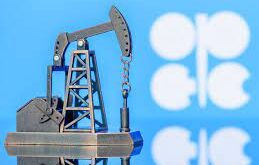The outcome of the meeting of the OPEC+ Joint Ministerial Monitoring Committee (JMMC) on Wednesday was as predicted.
OPEC+ — an alliance of the members of the Organization of the Petroleum Exporting Countries and 10 non-OPEC allies, led by Russia — will continue on the trajectory agreed in April, when members committed to cut production in the face of drastic demand destruction due to the COVID-19 pandemic. The number for September as per schedule is 7.7 million barrels per day (bpd). While significantly lower than the cuts made in May and June, it is still a historically high reduction.
What was foremost on the ministers’ minds was compliance, or rather the lack thereof, by several countries. Saudi Energy Minister Prince Abdul Aziz bin Salman framed the objective of the meeting during his opening speech, in which he referred to the “three Cs” — cuts, compliance and compensation — as the cornerstones of efforts to rebalance the oil markets.
The JMMC is co-chaired by Prince Abdul Aziz and Russian Energy Minister Alexander Novak. The latter took part in Wednesday’s videoconference session despite testing positive for COVID-19. This main focus of the meeting was firmly on the issues of compliance and compensation.
Saudi Arabia and Russia had agreed to make the most severe cuts to output, in particular the Kingdom, which had initially reduced production by more than a million bpd above and beyond its obligations under the OPEC+ agreement.
The main culprits who are failing to comply with the targets are Iraq and Nigeria, and during the July JMMC meeting some countries that had overproduced in the second quarter agreed to compensate for this by adjusting output during the third quarter.
These compensation efforts leave a lot to be desired. While the JMMC put overall compliance by OPEC+ members at 97 percent, in July Iraq’s compliance rate was only 83 percent and Nigeria’s was 65 percent, according to market analysts S&P Global.
Iraq has promised to make up for its previous overproduction; and to be fair, its compliance has improved from only 44 percent in May, according to S&P Global.
Prince Abdul Aziz was clear in his opening remarks that he expects all countries to have compensated for their overproduction by the end of September. OPEC did not provide any precise numbers for under-compliance but it said the countries guilty of it are expected to submit schedules by Aug. 28 explaining how they intend to remedy the situation.
It is no surprise that OPEC+ intends to adhere to the schedule of production cuts agreed in April. It was hard enough to get all 23 member nations to agree to a strategy at that time, when the oil markets were in an unprecedented state of turmoil as the effects of the growing pandemic drastically reduced demand.
It is the JMMC’s remit to monitor and recommend remedies to compliance problems, and this is what it has done. OPEC+ modulates supply. In terms of demand predictions, Prince Abdul Aziz said in his opening remarks that he is encouraged by the fact that the three most relevant organizations — OPEC, the International Energy Agency (IEA) and the US Energy Information Agency — expect demand at the end of this year to be back to about 97 percent of 2019 levels. This would be a huge improvement on April, when demand was down by almost 30 percent.
However, while we have seen some reductions of crude inventories, and while the IEA predicts a slight demand overhang for the second half of the year, the picture is neither rosy nor predictable: For the full year, demand is down by 8.1 million bpd compared with last year.
Last week, the IEA revised downward its forecasts for 2020, by 140,00 bpd, and 2021, by 240,000 bpd, with the lackluster recovery of air travel being the agency’s main concern.
One should also keep an eye on the slowing economic growth in the US, which is not being helped by the political stalemate over the stimulus package. While China’s oil demand has more or less returned to pre-pandemic levels, US-China trade sanctions might dampen the outlook, not only on the trade front but also for Chinese economic growth.
In other words, the oil market is starting to rebalance but gingerly, and only with a massive helping hand from OPEC+ in the form of massive production cuts. Any increase in demand will depend on how quickly economies recover from the pandemic, which in turn depends on the course of the virus and a possible second wave of infections.
The coming months will reveal whether the scheduled OPEC+ production cuts are sufficient, which is why the JMMC has stressed the fragility of, and significant uncertainties in, the market.
One thing is for certain: The leaders of the oil alliance have made it clear that it is unfair to expect them to continue to bear the brunt of the pain if others ignore their obligations. Vigilance makes sense in light of the tenuous macroeconomic circumstances.

 Iran Energy News Oil, Gas, Petrochemical and Energy Field Specialized Channel
Iran Energy News Oil, Gas, Petrochemical and Energy Field Specialized Channel



